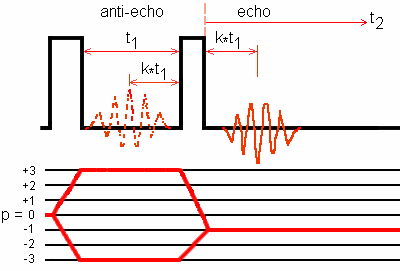
Amplitude-modulated two-pulse program
for 3QMAS of half-integer spin quadrupole nuclei.
Contribution of R. Hajjar

Amplitude-modulated two-pulse program
for 3QMAS of half-integer spin quadrupole nuclei.
Contribution of R. Hajjar
Below NMR pulse program describes the basic two-pulse sequence for (1D and 2D) +3Q-MAS experiment applied to quadrupolar nuclei with half-integer spin.

Fig. 1: Amplitude-modulated two-pulse 3QMAS NMR pulse sequence and coherence
transfer pathway.
The echo amplitude and the antiecho amplitude have
opposite signs.
The phase cyling is discussed.
This NMR pulse program is for Bruker Avance spectrometers.
An absorption 2D spectrum is obtained with the shearing transformation.
; 2p3q ; 3Q MAS pulse program for half-integer spin nuclei ; excitation - t1(±3Q) - conversion (-1Q) - ACQ(-1Q) ; Optimise P2 then P1, 2 or more iterations for P1 and P2 ; may be needed. ; For processing shearing transformation may be requested, ; use AU program xfshear ;parameters: ;ns : 24*n ;d1 : recycle delay ;p1 : excitation pulse at pl11 ;p2 : conversion pulse at pl11 ;pl1 : = 120 db (not used) ;pl11 : power level for excitation and conversion pulses ;d0 : = 1u or longer ;in0 : 1 rotor period for synchronised experiment ;td1 : number of t1-experiments ;FnMODE : States ;MC2 : States ze ; clear memory, new data replace old data, ; switch AD converter to replace mode, ; perform DS before next acquisition, 1 d1 ; recycle delay, 10u pl11:f1 ; 10 microsecond delay, ; set high power in f1 channel, (p1 ph1):f1 ; high-power excitation pulse, d0 ; delay between pulses, t1 increment, (p2 ph2):f1 ; high-power conversion pulse, go=1 ph31 ; signal acquisition, ; loop to 1, ns times for averaging, d1 mc #0 to 1 F1PH(ip1, id0) ; delay for disk I/O, store signal, ; increase FID number, ; delete memory data, ; do not perform dummy scans ; with next acquisition, ; increment p1 pulse phases by 360°/12 for States procedure, ; increment time d0 by in0, exit ; end of the pulse program ph1=(12) {0 2 4 6 8 10}^3^6^9 ; excitation pulse phase with CYCLOPS ph2= {0 0 0 0 0 0 }^1^2^3 ; conversion pulse phase with CYCLOPS ph0= 0 ph31= {0 2 0 2 0 2 }^1^2^3 ; receiver phase with CYCLOPS